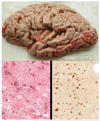The non-fluent/agrammatic variant of primary progressive aphasia
- PMID: 22608668
- PMCID: PMC3361730
- DOI: 10.1016/S1474-4422(12)70099-6
The non-fluent/agrammatic variant of primary progressive aphasia
Abstract
The non-fluent/agrammatic variant of primary progressive aphasia (naPPA) is a young-onset neurodegenerative disorder characterised by poor grammatical comprehension and expression and a disorder of speech sound production. In an era of disease-modifying treatments, the identification of naPPA might be an important step in establishing a specific cause of neurodegenerative disease. However, difficulties in defining the characteristic language deficits and heterogeneity in the anatomical distribution of disease in naPPA have led to controversy. Findings from imaging studies have linked an impairment of this uniquely human language capacity with disruption of large-scale neural networks centred in left inferior frontal and anterior superior temporal regions. Accordingly, the pathological burden of disease in naPPA is anatomically focused in these regions. Most cases of naPPA are associated with the spectrum of pathological changes found in frontotemporal lobar degeneration involving the microtubule-associated protein tau. Knowledge of these unique clinical-pathological associations should advance care for patients with this important class of neurodegenerative diseases while supplementing our knowledge of human cognitive neuroscience.
Copyright © 2012 Elsevier Ltd. All rights reserved.
Figures



References
-
- Pick A. Uber die Beziehungen der senilen Hirnatrophie zue Aphasie. Prager Medicinische Wochenschrift. 1892;17:165–7.
-
- Serieux P. Sur un cas de surdite verbale pure. Revue Medicale. 1893;13:733–50.
-
- Mesulam MM. Slowly progressive aphasia without generalized dementia. Annals of Neurology. 1982;11:592–8. - PubMed
-
- Mesulam MM. Primary progressive aphasia. Annals of Neurology. 2001;49:425–32. - PubMed
Publication types
MeSH terms
Grants and funding
LinkOut - more resources
Full Text Sources

